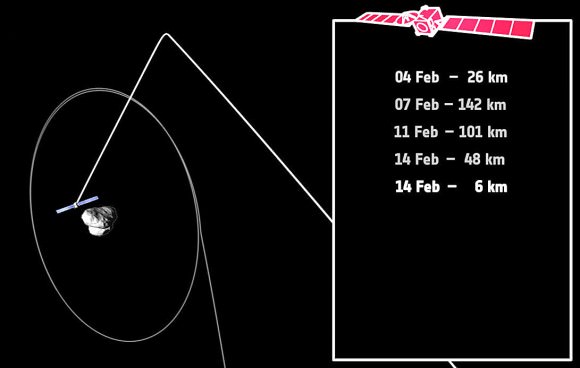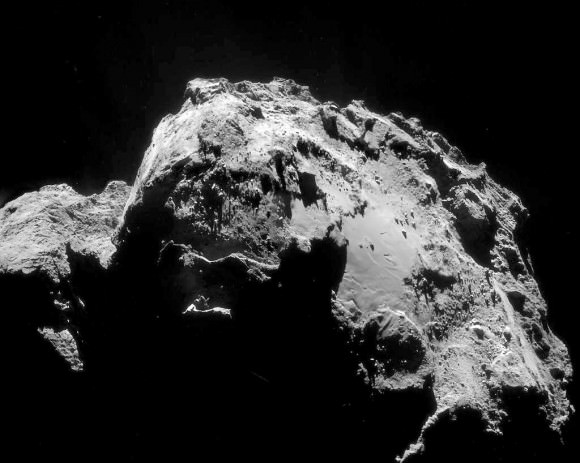Who doesn’t like to snuggle up with their Valentine on Valentine’s Day? Rosetta will practically whisper sweet nothings into 67P’s ear on February 14 when it swings just 3.7 miles (6 km) above its surface, its closest encounter yet.
Rosetta had been orbiting the comet at a distance of some 16 miles (26 km) but beginning yesterday, mission controllers used the spacecraft’s thrusters to change its orbit in preparation for the close flyby. First, Rosetta will move out to a distance of roughly 87 miles (140 km) from the comet this Saturday before swooping in for the close encounter at 6:41 a.m. CST on Feb. 14. Closest approach happens over the comet’s larger lobe, above the Imhotep region.

The close encounter will provide opportunities for Rosetta’s science instruments to photograph 67P’s surface at high resolution across a range of wavelengths as well as get a close sniff of what’s inside its innermost coma or developing atmosphere. Scientists will also be looking closely at the outflowing gas and dust to see how it evolves during transport from the comet’s interior to the coma and tail.
As Rosetta swoops by its view of the comet will continuously change. Instruments will collect data on how 67P’s dust grains reflect light across a variety of orbital perspectives – from shadowless lighting with the Sun at the orbiter’s back to slanted lighting angles – to learn more about its properties.

“After this close flyby, a new phase will begin, when Rosetta will execute sets of flybys past the comet at a range of distances, between about 15 km (9 miles) and 100 km (62 miles),” said Sylvain Lodiot, ESA’s spacecraft operations manager.
During some of the close flybys, Rosetta trajectory will be almost in step with the comet’s rotation, allowing the instruments to monitor a single point on the surface in great detail as it passes by.
Helpful animation of how ESA mission controllers are changing Rosetta’s orbit to ready the probe for the Valentine’s Day flyby.
Perihelion, when the comet arcs closest to the Sun at a distance of 115.6 million miles (186 million km), occurs on August 13. Activity should be reaching its peak around that time. Beginning one month before, the Rosetta team will identify and closely examine one of the comet’s jets in wickedly rich detail.
“We hope to target one of these regions for a fly-through, to really get a taste of the outflow of the comet,” said Matt Taylor, ESA’s Rosetta project scientist.
Yum, yum. Can’t wait for that restaurant review!

